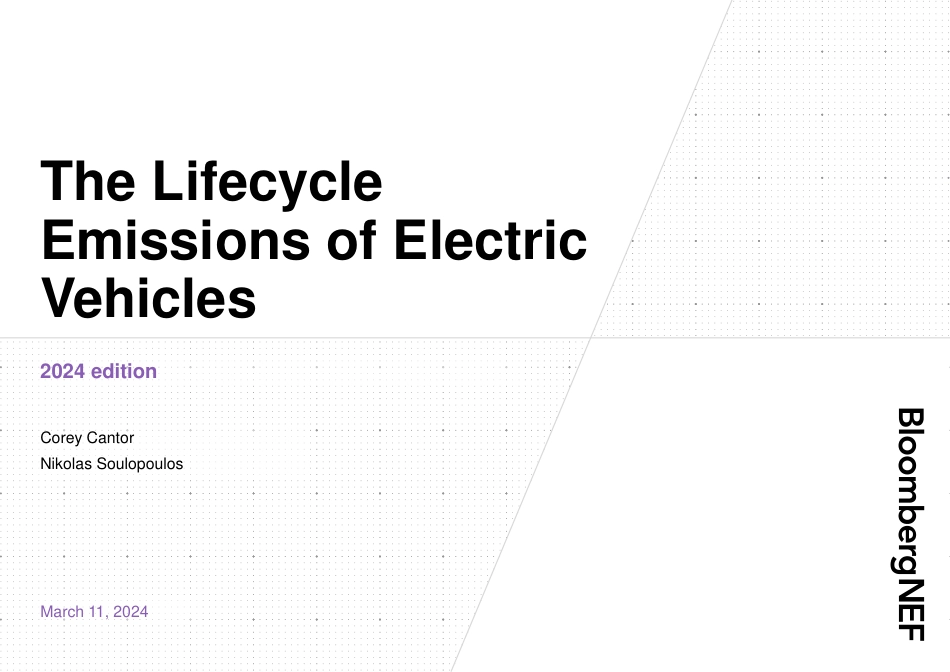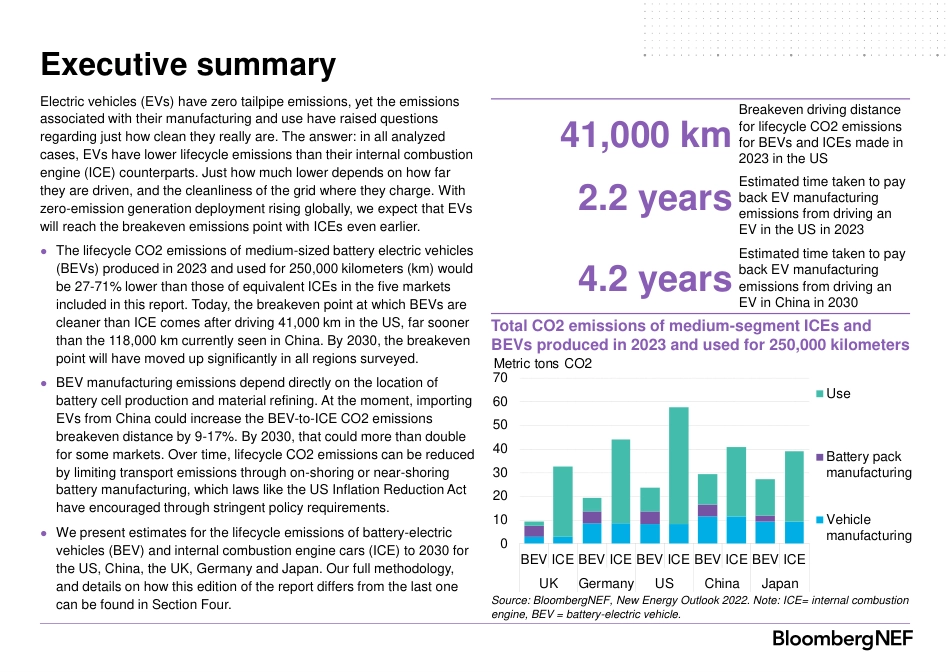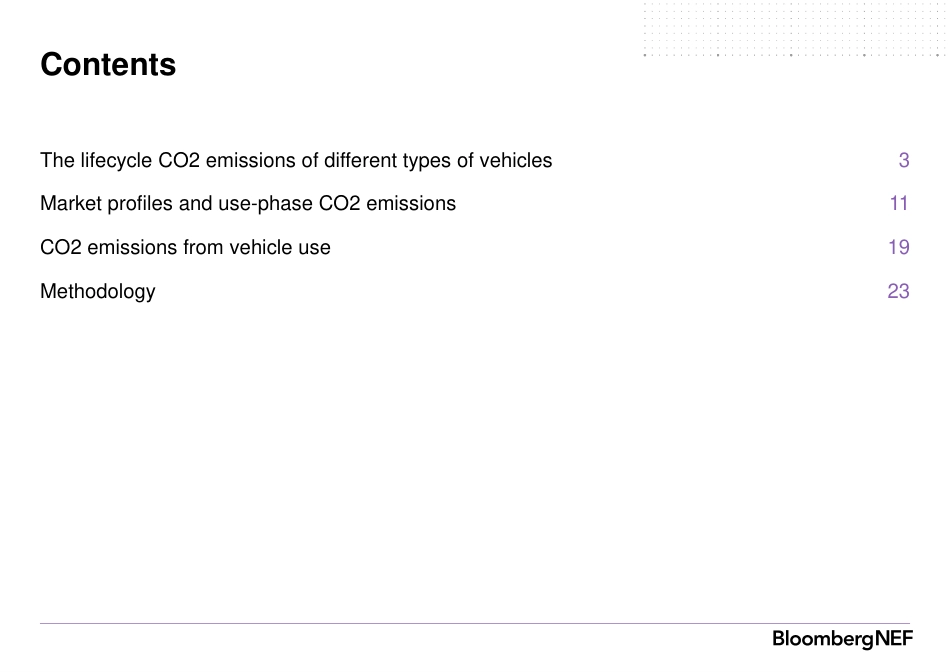TheLifecycleEmissionsofElectricVehicles2024editionCoreyCantorNikolasSoulopoulosMarch11,20241BNEFElectricvehicles(EVs)havezerotailpipeemissions,yettheemissionsassociatedwiththeirmanufacturingandusehaveraisedquestionsregardingjusthowcleantheyreallyare.Theanswer:inallanalyzedcases,EVshavelowerlifecycleemissionsthantheirinternalcombustionengine(ICE)counterparts.Justhowmuchlowerdependsonhowfartheyaredriven,andthecleanlinessofthegridwheretheycharge.Withzero-emissiongenerationdeploymentrisingglobally,weexpectthatEVswillreachthebreakevenemissionspointwithICEsevenearlier.●ThelifecycleCO2emissionsofmedium-sizedbatteryelectricvehicles(BEVs)producedin2023andusedfor250,000kilometers(km)wouldbe27-71%lowerthanthoseofequivalentICEsinthefivemarketsincludedinthisreport.Today,thebreakevenpointatwhichBEVsarecleanerthanICEcomesafterdriving41,000kmintheUS,farsoonerthanthe118,000kmcurrentlyseeninChina.By2030,thebreakevenpointwillhavemovedupsignificantlyinallregionssurveyed.●BEVmanufacturingemissionsdependdirectlyonthelocationofbatterycellproductionandmaterialrefining.Atthemoment,importingEVsfromChinacouldincreasetheBEV-to-ICECO2emissionsbreakevendistanceby9-17%.By2030,thatcouldmorethandoubleforsomemarkets.Overtime,lifecycleCO2emissionscanbereducedbylimitingtransportemissionsthroughon-shoringornear-shoringbatterymanufacturing,whichlawsliketheUSInflationReductionActhaveencouragedthroughstringentpolicyrequirements.●Wepresentestimatesforthelifecycleemissionsofbattery-electricvehicles(BEV)andinternalcombustionenginecars(ICE)to2030fortheUS,China,theUK,GermanyandJapan.Ourfullmethodology,anddetailsonhowthiseditionofthereportdiffersfromthelastonecanbefoundinSectionFour.Source:BloombergNEF,NewEnergyOutlook2022.Note:ICE=internalcombustionengine,BEV=battery-electricvehicle.ExecutivesummaryTotalCO2emissionsofmedium-segmentICEsandBEVsproducedin2023andusedfor250,000kilometers41,000kmBreakevendrivingdistanceforlifecycleCO2emissionsforBEVsandICEsmadein2023intheUS2.2yearsEstimatedtimetakentopaybackEVmanufacturingemissionsfromdrivinganEVintheUSin20234.2yearsEstimatedtimetakentopaybackEVmanufacturingemissionsfromdrivinganEVinChinain2030010203040506070BEVICEBEVICEBEVICEBEVICEBEVICEUKGermanyUSChinaJapanMetrictonsCO2UseBatterypackmanufacturingVehiclemanufacturing2BNEFContentsThelifecycleCO2emissionsofdifferenttypesofvehicles3Marketprofilesanduse-phaseCO2emissions11CO2emissionsfromvehicleuse19Methodology233BNEFThelifecycleCO2emissionsofdifferenttypesofvehiclesComparingbattery-electricandinternalcombustionenginecars4BNEFSource:BloombergNEFNewEnergyOutlook2022.Note:CCSiscarboncaptureandstorage,gCO2/kWhisgramsofCO2perkilowatt-hour.GlobalelectricitygenerationElectricitygridemissionsfactorsAchangingglobalpowergenerationmixissettolowerEVlifecycleemissions●Electricvehiclesareonlycleanifthepowertheyuseisproducedwithoutemissions.UndertheEconomicTransitionScenario(ETS)inBNEF’sNewEnergyOutlook2022(web|terminal),theglobalshareofzero-carbonelectricitygenerationincreasesfrom45%in2023to74%by2040.Zero-carbongenerationsharesdifferwidelyacrossgeographies,butforallfivemarketsinthisreport,itaccountsforatleasthalfofgenerationby2040.●Asrenewableenergydeploymentincreases,theaverageemissionsintensityofmostpowergridsacrosstheworldwilltrenddownwards.MeasuredingramsofCO2emittedperkilowatt-hourofelectricityproduced(gCO2/kWh,showninthetab...



 VIP
VIP VIP
VIP VIP
VIP VIP
VIP VIP
VIP VIP
VIP VIP
VIP VIP
VIP VIP
VIP VIP
VIP